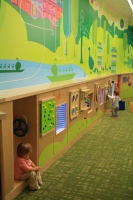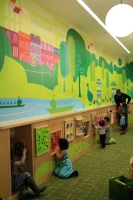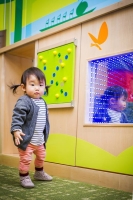Pathway to Reading Sensory Wall
Boston Public Library, Mass.
Innovation Synopsis
The Pathway to Reading Sensory Wall is an interactive feature in ToddleTown, the early literacy area in the Boston Public Library’s newly renovated Children’s Library. It engages children ages zero to three and children with sensory processing disorders by building an exploratory environment for young visitors and promoting brain development.
Challenge/Opportunity
Multi-sensory engagement is vital for infant brain development, and libraries have a unique opportunity to serve very young children. The sensory play provided by the Pathway to Reading is not only fun, it helps children under three learn through experience and develop essential skills. Offering a variety of opportunities for child-directed sensory engagement facilitates exploration that leads to cognitive, linguistic, social and emotional, and physical learning. It also creates opportunities for staff to model learning behaviors for caregivers. Sensory processing disorders are often seen in conjunction with autism spectrum disorders. Opportunities for multi-sensory engagement in welcoming, comfortable spaces are vital for children with sensory processing disorders. The Pathway to Reading offers an inclusive space for children to stimulate their senses in a playful, child-directed environment.
Key Elements of Innovation
Like many libraries, ToddleTown incorporates tactile panels that encourage exploration. The Pathway to Reading takes this idea further using technology found in sensory rooms. With input from special educators, we incorporated LED panels, bubble tubes, and additional elements to create a space that creates an engaging and inclusive environment. These resources also facilitate learning through sensory experience for all young children. Expansion of programming for young children and children on the autism spectrum are an essential part of this patron experience. Adding an early literacy librarian and regular programming for children on the autism spectrum makes this space come alive.
Achieved Outcomes
Our primary intended outcome was to create an engaging space that both fosters infant brain development in young children and provides an inclusive environment for children with sensory processing disorders. Patron feedback and staff experience indicate that we have achieved that goal. Continuing goals for the space include expanding on our robust and popular programming for children ages zero to three, which will be facilitated by the hire of a librarian with a special focus on early literacy. We are also expanding programming for children on the autism spectrum and developing relationships with local organizations working with this underserved population. We intend to make the Pathway to Reading a destination for all families with young children and for families with children on the autism spectrum.



